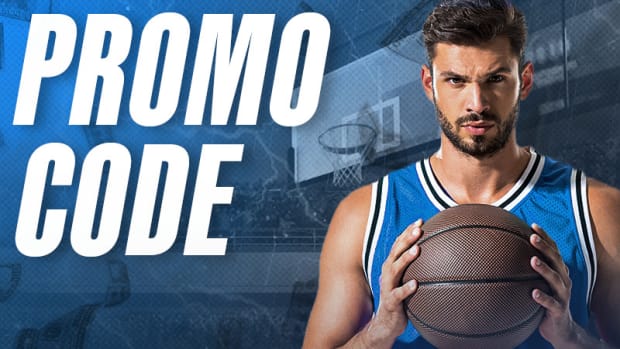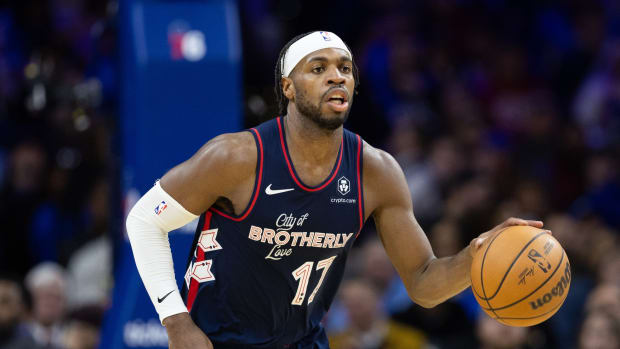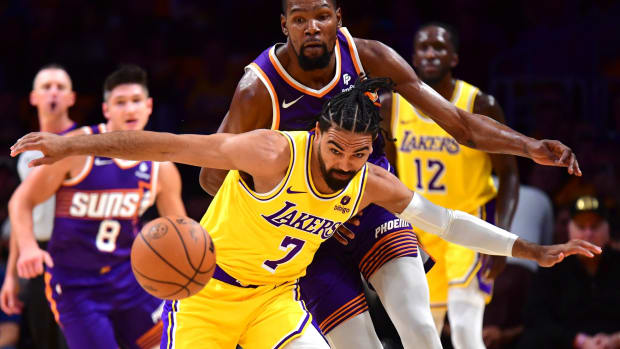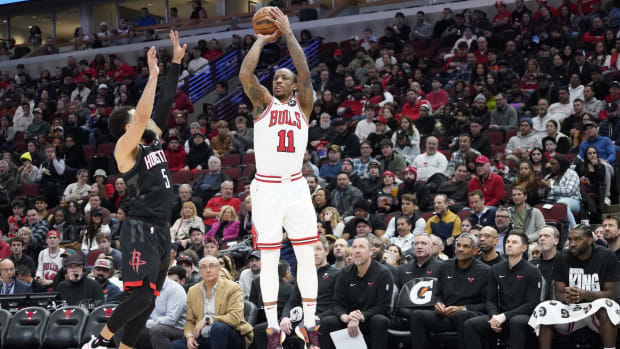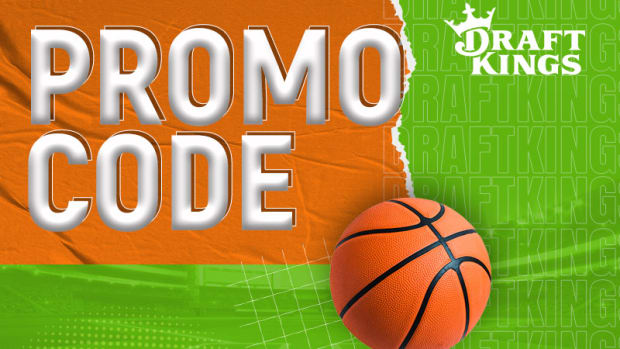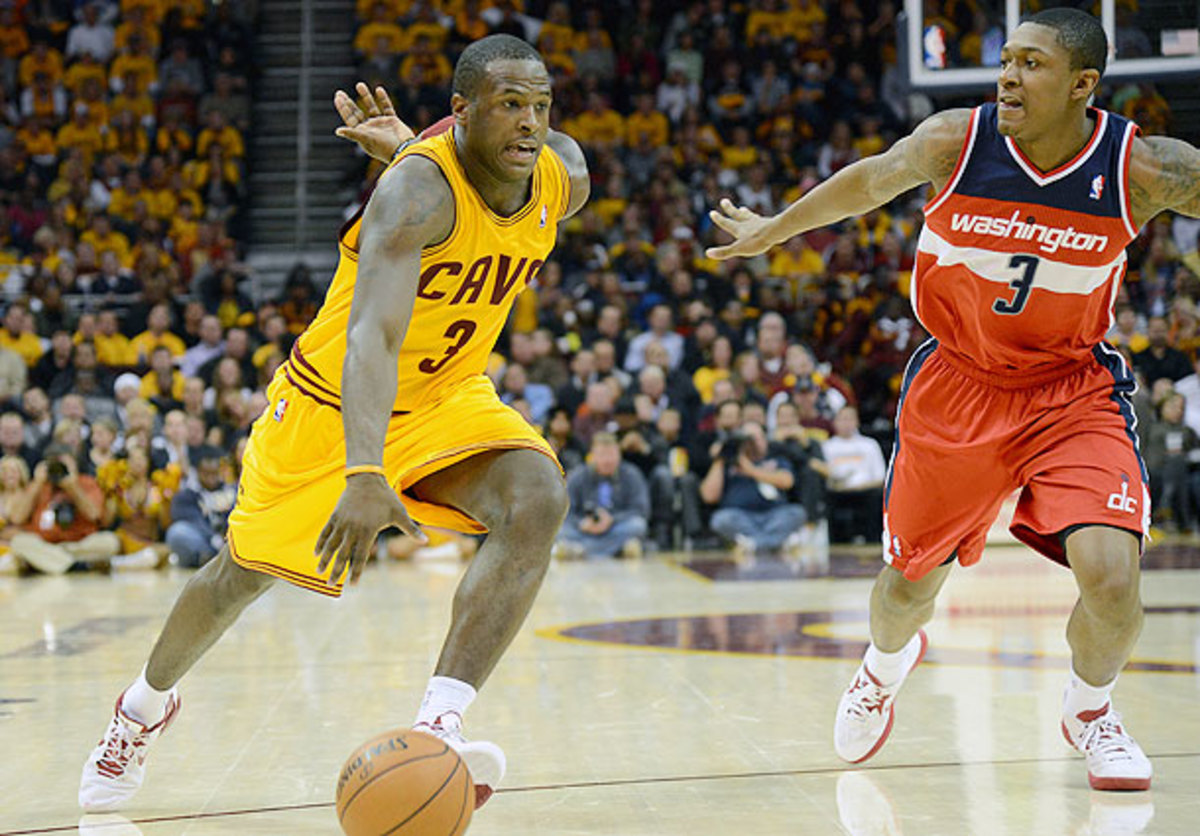
Examining the overlooked rookies
Dion Waiters is already showing he can be a volume scorer in the NBA. (Jason Miller/Getty Images)
By Rob Mahoney
Damian Lillard and Anthony Davis took an early stranglehold on the Rookie of the Year race and have been so tremendously productive that they've obscured most other first-year players. So today, we respectfully put those two standouts aside, fantastic though they may be, for the sake of checking in with the rest of this year's rookie class. The following 15 rookies have been chosen solely by sample size, as they (excepting Lillard) have logged the most overall minutes of all first-year players, but have been sorted and dissected for your reading and scouting pleasure.
PROSPECTS IN PROGRESS
Dion Waiters, Cleveland Cavaliers
Waiters already has volume scorer written all over him only a month into his NBA career. But it should be interesting to see how the Cavs' eventual roster shaping affects Waiters' shot selection. Though he and point guard Kyrie Irving essentially have carte blanche to hoist up shots, Waiters' optimal NBA utility will require that he rein in his bulk shooting attempts and tone down his driving game to the point where he can actually convert some of the looks he's creating. Waiters has some nice ball skills (including a decent off-hand) and can use the pick-and-roll to launch toward the rim by either splitting defenders or wheeling around them.
That said, once Waiters creates a sliver of space, he hurls himself toward the basket without regard for help defense or the potential for the slightest creativity. His basketball world is composed of binaries and straight lines, and that kind of stripped-down court view often does him more harm than good. If Waiters starts to identify the context of the game more clearly (a big if, given that we've long waited for so many players to come to a similar realization), his field-goal percentage will jump. If not, he may prove to be equal parts help and imposition to Cleveland's offense.
There's some fun two-way potential for Waiters and Irving to work off one another, and the roots of their fledgling chemistry are already apparent. The relationship is a bit stilted at this point, as Waiters is often too preoccupied with barreling toward the rim to actually read the passing lanes created by his drives. But with both players capable of initiating the offense and knocking down spot-up looks on the weak side (Waiters has converted an impressive 51.6 percent of his spot-up three-point attempts, per Synergy Sports Technology), the Cavs could have the foundation of a sound drive-and-kick system. That assessment banks on some improvement in Waiters' playmaking judgment, but we can safely assume that some gains will be made in that regard over the next few seasons.
Harrison Barnes, Golden State Warriors
Barnes may be best known for his pure bucket-getting ability, but his first month as a pro has actually offered a far more exciting glimpse at his defensive potential. He has done a nice job defensively for a Warriors team that is somehow hovering around the league average in points allowed per possession without center Andrew Bogut, and Barnes has the physical tools and mentality to be an exquisitely balanced player going forward. "Three-and-D" wing specialists are valuable in their own right, but Barnes -- who has converted 36 percent of his long-range tries -- ultimately has the capacity to score on drives and pull-up attempts in addition to those basic functions. He may never be the star scorer whom so many expected him to be, but Barnes is already a pretty reliable NBA defender and has room to grow slowly into a more complex offensive role.
Jonas Valanciunas, Toronto Raptors
With Andrea Bargnani struggling, Valanciunas is the Raptors' one true frontcourt hope. Valanciunas is so many things that Bargnani is simply not -- a competent rebounder, a good finisher, a patient participant in Toronto's offense -- and it's in that separation that he gives the Raptors a much-needed relief. Even on a team hit hard by injuries at already weak positions, Bargnani's chucking act has grown stale, and his defensive devolution has mitigated much of promise born from an incredible start to the 2011-12 season. He's worn out his welcome and shows no sign of changing his game in a way that would make him more amenable to a team still establishing its defense-first identity.
That makes everything Valanciunas does looks rather rosy by comparison. There's a certain glow surrounding Valanciunas these days, built in part by his game and personality, but also due to the fact that he gives coach Dwane Casey a theoretical Bargnani alternative and a promising prospect. Casey clearly has his reservations about playing Valanciunas heavy minutes (he's averaging just over 24 minutes a game), but there's no question that the Raps' future rests with the 20-year-old Lithuanian and his eventual development.
The early returns have been rather mixed, as is typically the case with rookies. His ability to convert dunks and layups is somewhat offset by the trouble he has navigating the lane while rolling toward the rim. His shot-blocking ability is mitigated by the fact that he gets completely crossed up in his defensive rotations at times and has been frequently caught out of position. He's experimenting with a mid-range set shot that would be a valuable expansion to his game, but hasn't yet had much success. He's a useful player with a bright future, but let's not let Bargnani's struggles paint Valanciunas as anything more than he is -- a talented, developing big man deserving of more minutes and a slightly longer leash.
Michael Kidd-Gilchrist, Charlotte Bobcats
It's hardly uncommon for a 19-year-old prospect to arrive on the NBA scene with underdeveloped skills, but it's more unusual to see that very same prospect work off instincts that are so far ahead of his technical game. MKG is clearly still feeling out the nature of the NBA basketball, but for the most part his actions and decisions are fundamentally correct. Every move with the ball is decisive, and Kidd-Gilchrist's willingness to pass on a fleeting opportunity rather than force the issue displays a wisdom well beyond his years. But with a wacky jumper that's as unnatural in form as it is in flight and an altogether shaky capacity to finish at the rim, Kidd-Gilchrist simply isn't as productive on the offensive end as most would expect of a top-three pick.
With such a sound decision-making framework in place, though, Kidd-Gilchrist will now have the repetition and practice necessary to flesh out his skills during the Bobcats' formative years. He's already rebounding at an elite rate for a small forward, as his 13.5 total rebounding percentage mirrors the marks of Kevin Durant and Shawn Marion. He's particularly clever on the offensive glass (where he demands a box-out even on the perimeter), and does a nice job of hunting down out-of-position boards on the defensive end. Toss in his quick feet and sound defensive fundamentals, and there's plenty with which to work. But until MKG eliminates some of his offensive quirks, the Bobcats will simply have to make do with a utility scorer who can't be depended on to create open looks, even as he converts broken plays and impromptu counters to drop a perfectly decent 14.9 points per 36 minutes.
Andre Drummond, Detroit Pistons
The key for players considered to be long-term projects is to find simple ways to stay on the floor. It doesn't take much; when a team and coach have a vested interest in a player's development, a few basic skills can go a long way toward validating potential playing time. For some, it may be converting open jumpers. For others, displays of pure effort. For Drummond, his instant validation comes through his rebounding -- an area of the game in which the 6-foot-10 center is performing at an elite rate, as only two NBA players have posted higher overall rebounding percentages. He's earned his ticket to more playing time through that kind of display alone, and now it's on Pistons coach Lawrence Frank to afford Drummond with even more opportunities to play, produce and grow.
And boy, is there a lot of room for growth. Drummond's about as raw as a reasonably productive player can be, and the few post moves he's attempted have resulted in wild flings in the general direction of the hoop. About a third of Drummond's field goals have been dunks, and he's converted only 48 percent of his attempts otherwise -- a cut that may seem decent until you consider that 96 percent of Drummond's shot attempts have come in the deep paint or the low block. He simply struggles in any situation that requires finesse and lacks the kind of touch on his interior attempts that would allow him to score over or around defenders. His ebounding and shot-blocking should buy him plenty of time to settle into his offensive and defensive game (don't mistake Drummond's monster block numbers for defensive nuance), but there's a long road ahead.
The Hornets are currently playing better with Austin Rivers on the bench. (Layne Murdoch/NBAE via Getty Images)
THE CONCERNING
Austin Rivers, New Orleans Hornets
Rivers has had a miserable first month, to the point that the Hornets -- who are already missing Eric Gordon and Davis and relying heavily on Greivis Vasquez, mind you -- are actually better with Rivers off the floor. He's an all-offense player who frankly doesn't look comfortable when participating in an orchestrated effort. The problem isn't that Rivers is inherently selfish; his game is simply isolation-driven, and far too inefficient for NBA dependency. Some can get by with a similar approach given their physical advantages or exemplary shooting, but Rivers has neither working in his favor. He's physically unremarkable by NBA standards, only a decent shooter and can't create enough off the bounce to warrant investing a considerable number of possessions in his game.
There was plenty of hand-wringing when the Hornets selected the positionally redundant Rivers with the 10th pick, and the headache of balancing Rivers and Gordon is yet to come. But for now, Rivers and coach Monty Williams still have plenty to figure out, as they rummage for ways to stretch and contort a bundle of inefficiency into a useful basketball player.
Bradley Beal, Washington Wizards
Beal's NBA potential was sold on the notion of him working as a floor-spacer and spot ball-handler, which is reason enough to table evaluations of his game until we get a look at a functional Wizards team. There have definitely been some disappointing trends in Beal's performance and shot selection, but it doesn't seem entirely fair to judge him in the context of such a strange team, particularly when he's being asked to do far more initially than the Wizards thought he might be. Let's hope that Beal's growing pains will be eased by having the likes of point guard John Wall and center Nene (who only recently returned to the lineup) around to attract defensive attention and create open shots, thus affording Beal the opportunity to work in a more natural supporting role.
Still, that 39.1 effective field-goal percentage (which factors in the added value of three-pointers) is pitiful, and Beal is doing himself no favors by avoiding actual dribble penetration at all costs.
Alexey Shved has proved to be a lifeline for a battered Wolves team. (David Sherman/NBAE via Getty Images)
THE INSTANT PROS
Alexey Shved, Minnesota Timberwolves
The Russian rook has made for a stellar life preserver in some particularly tough spots for the Timberwolves. His game can be too bold for its own good, but Shved's aggressive driving and confident shooting (even when his early percentages gave him little reason for such confidence) gave Minnesota just what it needed in the absences of Ricky Rubio, Brandon Roy and J.J. Barea, among others.
Never before has a combo guard been such a perfect match for a team's needs; Shved's shot-creating skills have been vital to the offense, and he has consistently anchored the Wolves' late-game efforts when given the opportunity. He'll likely wind up buried beneath the assortment of options that coach Rick Adelman will eventually have in his backcourt (hell, Adelman is finding ways to play Malcolm Lee over Shved now, with Rubio and Roy still out of the lineup), but that shouldn't diminish the importance of Shved's production at a time when the Wolves' rampant injuries demanded a lifeline.
Kyle Singler, Detroit Pistons
Singler -- who played for Real Madrid last season after being selected No. 33 in the 2011 draft -- doesn't play at all like a rookie. He genuinely works the perimeter instead of just standing around on the weak side, exploits his opponents' inattention on a consistent basis and already converts his three-point attempts at an incredible clip (47 percent!) thanks to the passing lanes he creates with his off-ball movement. He's a decent on-ball defender, does a good job of shuffling to deny dribble penetration and works hard to get over screens and close out on shooters. His game isn't yet fully developed, but already it holds startling similarity to that of the handyman veteran, capable of filling minutes and actually contributing without any clear vulnerabilities.
The key is positioning Singler in an appropriately limited role. As much as I like Singler's game, he isn't very quick with the ball and can pretty much only get into the paint off the dribble by way of a very guardable spin move. But he's exactly the kind of player that the Pistons will be happy to have around in a few years, once Singler's supporting act is given new meaning within the context of a more effective team.
Jae Crowder, Dallas Mavericks
The Mavericks don't have the best draft-day record, but picking up Crowder -- a rotation-caliber player acquired with a second-round pick -- so late in the 2012 Draft was a hell of a move. For a wing player, Crowder is already incredibly disruptive when crashing into the paint as a help defender, and he frequently strips ball handlers or forces miscues through his well-timed digs. That helping tendency can haunt Crowder and the Mavs in matchups against intuitive cutters, but for the most part it's a legitimate benefit for a team that's largely struggled to halt opponents from getting to the rim.
Crowder can be a bit eager offensively, but he attacks with the best of intentions -- he just doesn't manage contested looks around the basket particularly well, and has a bad habit of jumping into an attempt even when he's at a clear disadvantage. Crowder counters those issues with consistent movement and an unheralded spot-up game; though Crowder's jumper was considered a work in progress going into this season, he has made 38 percent of his three-pointers while attempting 6.3 per 36 minutes. That's a solid shooting mark that should only improve once Dirk Nowitzki is around to pull in defenses, and doesn't even account for Crowder's incremental development as a scorer.
Festus Ezeli, Golden State Warriors
Ezeli has filled minutes admirably for a Golden State team that's doing surprisingly well without its defensive anchor, so much so that the Warrior defense is six points stingier per 100 possessions with Ezeli on the court. The fact that a rookie could actually move a mammoth center like Nikola Pekovic off his spot in the post is pretty crazy in itself, but Ezeli regularly uses his strength and size to good technical advantage when defending the block. He hasn't shown much improvement in guarding pick-and-rolls (he still sags below the screen, a la Brook Lopez), though that could simply be part of coach Mark Jackson's curious defensive design.
Either way, things are pretty cheery for Ezeli as long as we neglect to mention the offensive end, where he's unable to create anything with his back to the basket and refuses to fire from anywhere else. There's a reason, though, why he shoots just six times per 36 minutes. Though Ezeli has been fiddling around with a quick counter spin to help create room for his hook shot, he has a hard time aligning the leverage and angles necessary to consistently execute decent attempts, and often defers by passing the ball out and resetting the offense.
Jared Sullinger has struggled with the length and athleticism of NBA defenders. (Brian Babineau/NBAE via Getty Images)
THE HO-HUM
Jared Sullinger, Boston Celtics
Now that the Celtics' faithful has quieted with its preseason urgings to save a spot for Sullinger in the Hall of Fame, we can reflect more seriously on a player who entered the league fairly NBA-ready but is probably best served in an extremely limited role. Sullinger hasn't been asked to do all that much for the Celtics and, as a result, hasn't been a liability. He doesn't commit turnovers due to only receiving the ball in optimal circumstances and an innate tendency to make straightforward offensive plays, and, accordingly, he's been able to carve out a reasonably efficient game. His biggest obstacle on that end is simply the size he surrenders to defenders. According to Hoopdata, 18.8 percent of Sullinger's shot attempts are blocked, the fifth-highest mark in the league. It'll take time to fully adapt to the size and athleticism of NBA defenders (his teammate Brandon Bass provides a perfect example of that learning curve), but for the moment Sullinger's selective deployment mitigates his inexperience.
But Boston can't fully hide Sullinger defensively, particularly when Kevin Garnett isn't on the floor. Sullinger doesn't have the ability to rotate and recover quickly enough for Boston to defend consecutive play actions, and he's guilty of ball-watching when zoning up on the weak side. He won't ever be a defensive standout, but the current goal is to make him passable -- an invisible cog in the Celtics' defensive machine, secure in the stable construction of the system. It's a work in progress, and coach Doc Rivers has experimented with using Sullinger in various combinations in hopes of piecing together back-line support to his defense while Garnett rests.
Jeff Taylor, Charlotte Bobcats
There's nothing terribly exciting about Taylor's game, but the Bobcats will certainly settle for the pedestrian these days given how the 2011-12 season dragged a poor roster through 66 games of public shaming. He doesn't create, he's merely passable as a defender and he largely parks in the weak-side corner in anticipation of a kick-out pass. But Taylor has converted threes at a slightly above-average rate (35.7 percent) for a team ranked 26th in three-point percentage, and is often the only dependable long-range shooting option on the floor in lineups that may also suffer in their spacing because of the limited offensive games of Brendan Haywood and Bismack Biyombo. He's not great, but for this Bobcats team, he's perfectly useful.
Meyers Leonard, Portland Trail Blazers
Leonard is an endangered species -- the exotic Trail Blazers reserve who is actually producing something worthwhile. Beyond that, though, Leonard is a variety of project big man that we've seen all too often before, empowered by the multitude of developmental paths at his disposal but ultimately limited in his current form. He could prove to be a nice piece, but how useful can he really be to the Blazers if he can't rebound in volume to offset LaMarcus Aldridge's too frequent struggles on the glass? And for how long will it be good enough to merely be active and athletic, considering that this team is still a defensive overhaul away from respectability? Leonard can't be charged with all of the flaws of Portland's roster, but he has a long way to go if he's to be anything other than a reasonably effective bench player.
Tyler Zeller, Cleveland Cavaliers
In today's NBA, Zeller walks the fine line of having a useful skill (he can step out of the paint and make mid-range jumpers) and relying on inherent inefficiency; without the capacity to get to the free-throw line, finish around the basket or stretch out to three-point range, Zeller relies on an assortment of shots that are unlikely to ever offer a dependable block of scoring. Ultimately, that makes him reliant on context. He can still find success with the right team in need of some mid-level floor spacing, but the limits of his approach -- and at present, the limits of his game -- relegate him to offensive afterthought. He does well to contribute in spite of that limitation, but if he doesn't expand his offensive repertoire, Zeller's career will always be a battle against the grain of efficiency.
Beyond that, he's a better rebounder than the numbers suggest, a factor of playing with Anderson Varejao. When Zeller has played without Varejao, he's corralled about 15 percent of available rebounds -- a mark equivalent to the rebound percentages of Al Horford and Roy Hibbert, and a point or so shy of Dwight Howard and Marcin Gortat. It may not seem terribly complementary to again only praise Zeller's game within a certain context, but them's the breaks; he's ceded to Varejao on the glass, and bears a similar risk of forfeiting boards to active opponents.
Statistical support for this post provided by NBA.com.


































